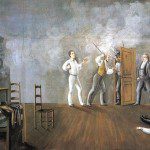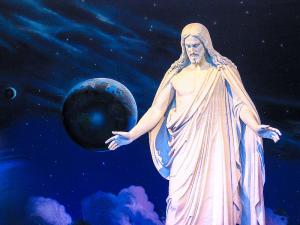In yesterday’s post, I discussed the relationship between Mormon illustration and historical accuracy, specifying that I’d prefer to see a efflorescence of approaches in the Mormon illustrative tradition.
To exhibit the analytical richness artistic diversity can encourage, I present From the Dust, a graphic novel project based on the Book of Mormon. There’s a major difference, however, from all previous illustrations of the Book of Mormon: in From the Dust there are no humans.

From left to right: Lemuel, Laman, Sam (on camel), Nephi, Sariah, Lehi.
That’s right: as in Zootopia, all the characters in From the Dust are bipedal, clothed animals— from Lehi, a hyena, to Nebuchadrezzar, a literal dragon. The settings make no pretension of historical accuracy: fanciful towers spiral up into the sky of ancient Jerusalem and Babylon. The beasts of burden look more like banthas than camels. And again as in Zootopia, divorcing the story from familiar human images allows us to approach the Book of Mormon from unaccustomed perspectives.
To offer one example: Michael Mercer, the series’ author and artist, chose to represent Laman and Lemuel as the same type of large canines as their father, while Sariah, Nephi, and Sam are more diminutive felines. Already there are questions: what in the world do Laman and Lemuel have more in common with Lehi than Nephi? The canids of the family all share dark fur, while the cats are sandy-colored: could this be a presaging of the curse on the Lamanites? If so, it is also a revisionist account: Lehi was also dark-furred. As a kitten, Nephi can hardly be described as “large in stature,” so we are forced to take a new view: what if the relevant category in Nephi’s familial relationships is not musculature, as Nephi would have it, but age? Laman and Lemuel certainly saw Nephi’s claim of leadership as a usurpation of their birthright, and Mercer’s choices of species and size help us perceive that implicitly. There might also be a gendered aspect here: Lehi, Laman, and Lemuel appear the most stereotypically masculine of the bunch, while Nephi’s association with his mother calls attention to elements of his character we might consider feminine.
Interestingly, though, From the Dust did not discard the historical. Indeed, one of Mercer’s primary goals was to provide historical context found in no other family entertainment based on the Book of Mormon. Lehi’s family is entirely absent from the first issue, which focuses on “The Last King of Judah”: the political background to the opening stories of the Book of Mormon. Asides, intended to be features on an interactive app, explain elements of Hebrew linguistics, scriptural context, and cultural references.
Due to funding stream problems, only one volume of From the Dust was published on schedule. For years, I lamented that the project had been mothballed.
To my pleasure and surprise, however, Mercer announced this past Friday that he’s considering starting a Patreon account to resurrect it! If you’re interested at all, go here to let him know!
I only hope that we can see more Mormon media willing to cast away attempts at strict historical literalism and expand in fascinating new directions. As Mercer quotes in the introduction to From the Dust, Tolkien once said that the Christian “may now, perhaps, fairly dare to guess that in Fantasy he may actually assist [God] in the effoliation and multiple enrichment of Creation.” I hope this can apply to Mormons as well, and that this “enrichment of Creation” can nourish souls who might be left hungry despite the cornucopia of history.












